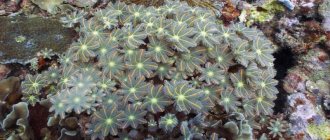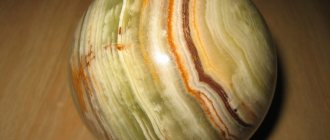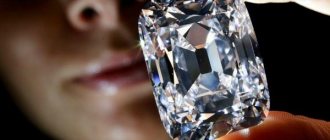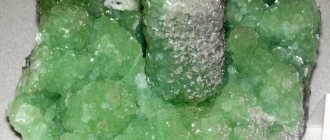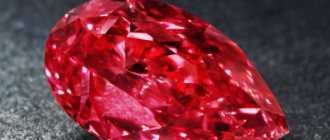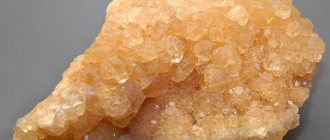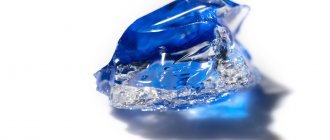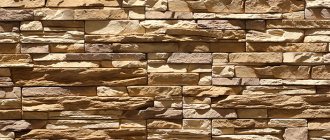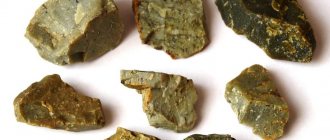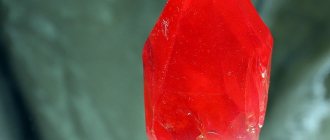Fossil coral (fossilized)
Fossil corals, like modern representatives of the class, are mineral skeletons built by colonial or solitary coral polyps
, relatives of sea anemones and distant relatives of jellyfish. Treasured by people since ancient times, corals still fascinate us with their beauty, and examples of extinct species are no exception.
Corals: a history of hundreds of millions of years
The “classical” samples that we are all accustomed to are classified as six-beam
and
eight-rayed
corals - although not all of their modern representatives have a solid mineral skeleton.
But two other subclasses - rugoses
and
tabulates
- completely disappeared at the end of the Paleozoic era, before the appearance of the first dinosaurs. The numerous fossils that remain from them allow us to imagine what warm, shallow seas looked like three to five hundred million years ago.
The heyday of four-ray corals is the Rugosa - Devonian and Carboniferous periods. Some of the most striking representatives are single “cups” of Gsheila
(which, by the way, received its name in honor of the village of Gzhel near Moscow) and the
Petalaxis
, the polished cuts of which, replaced by chalcedony, are highly valued by collectors far beyond the borders of Russia.
Tabulates
They are somewhat less famous, but they are also of considerable interest to collectors.
These corals, unlike any modern ones, consisted of interconnected tubes, often creating extensive colonies ( Syringopora
), or being foulers on solitary rugoses and brachiopod shells (
Aulopora
).
In the next Mesozoic era there was a flourishing of six-rayed
corals - madreporoids, or
scleractinians
.
Their modern representative is the brain coral
, which is shaped like the human brain.
And the most famous extinct representatives are the corals of the mountainous Crimea Latiphyllia
and
Cyathopora
, which are found in the vicinity of Balaklava, Bakhchisaray and Mount Ai-Petri.
Later, Cenozoic corals are also interesting. For example, Tarbellastrea
from the Miocene of Hungary attracts the attention of collectors with its unusual shapes and the fantastic preservation of some specimens.
Authentic fossil corals in the Stone Experts store
From us you can purchase both collectible specimens of Paleozoic and Mesozoic corals, as well as jewelry and other products made from them. Polished cuts of ancient coral colonies will decorate the interior, and a pendant with fossilized coral from Morocco or a necklace with red coral from modern tropical seas will add something new and unusual to your look.
We provide a 100% guarantee of authenticity for all corals and products made from them, and if you wish, you can additionally order a gemological examination certificate for any sample purchased from us.
Mining and stone processing
Corals grow very slowly, over hundreds and thousands of years, in the salty waters of the seas and oceans, forming thickets and reefs that reach the size of an island. Growth is possible at water temperatures above 21 °C.
Main places of growth:
- Caribbean Sea;
- Pacific Ocean;
- Indian Ocean;
- Canary Islands;
- Mediterranean Sea;
- Red sea.
The mining method has remained unchanged for many years - 2 long beams with nets at the ends are dragged along the bottom. The trapped minerals are raised to the surface and cleaned. Sorting is carried out manually according to size, quality, color of material. Next, the master polishes the corals and cuts them. He must see in advance what beads, cabochon, rose, oval or circle can be made from.
The master must preserve the material as much as possible - the yield of products is small. For example, 1 kg of mineral produces 350 g of beads; two threads of a necklace require 50–70 kg of raw materials.
Using thin needles, holes are drilled into the products, cooling with water, otherwise they will crack.
The final stage is adding shine. Products are soaked in a solution of soap and abrasive for 36 hours. This removes dirt, dust, and organic inclusions on the surface.
The resulting products go to jewelers and infilatrichi - women who string coral beads on threads.
Mineral care
Corals are difficult to care for. In order for the product to serve for many years, the following recommendations should be followed:
- protect the mineral from any mechanical impact - shock, scratching, squeezing, falling;
- exclude contact of the mineral with any chemicals - dishwashing and laundry detergents, cosmetics, perfumes;
- store corals at room temperature and a normal level of humidity - a sharp temperature change, high humidity or, conversely, too dry air can lead to damage to the integrity of the mineral;
- to store coral, use a separate box, and wrap the mineral itself in tissue paper (storing corals in polyethylene is not allowed);
- To clean corals from contamination, use a damp cloth; to dry, use a dry piece of flannel.
Medicinal properties
Among all nations, coral is considered a healing stone. Depending on the color, it has different effects on a person. Since coral is similar to human bones, powdered white coral is used for fusion and restoration of bone tissue. In Japan they went further and began to use it in dental prosthetics.
Pink corals help with insomnia and have a good effect on the nervous system.
Red coral strengthens the cardiovascular system and blood circulation. Helps with anemia.
Coral is an indicator of health, if the stone that a person wears retains its shine and structure, then the person is healthy, but if darkening and the appearance of wormholes are observed, then this is a reason to conduct a health diagnosis.
Compatibility with other stones
In jewelry, corals look harmonious with many stones. It is only necessary to take into account the color scheme and energy of the minerals. Thus, light-colored corals look good in tandem with colored minerals. Gems of bright red and dark colors combine well with stones of light beige tones.
Coral goes well with pearls, both from an aesthetic point of view and on an energetic level. The proximity of this mineral to amethysts, turquoise, lapis lazuli, agate, sapphire and onyx is no less favorable.
It is not advisable to combine coral in jewelry with malachite, sardonyx, jasper and beryl.
Coral and its physical properties
Coral is a calcareous skeleton of a marine invertebrate polyp that lives in tropical seas. They form tree-like structures with branches that form coral reefs and islands.
It got its name from the ancient Greek word “corallion”, which was the name for sea polyps. The stone is an opaque material, translucent when chipped, consisting of calcium and aragonite. It is very fragile and sensitive to high temperatures, acids, and hot water. Over time it fades and becomes cracked.
In its natural form, coral is unattractive and dull. It acquires its glassy shine and smoothness after it is polished by a master.
The magical properties of coral
Many legends and beliefs tell about the magical power of coral. In ancient Greece, pink coral was believed to give a person eternal life and eternal happiness. The Greeks wore coral amulets all their lives, believing that they protected against the evil eye and warded off illness and misfortune.
In India, corals are credited with the ability to protect a person from dangers and make him wise. In the East, he was valued for developing intuition and strengthening the gift of providence.
In Rus', the stone was considered prophetic, possessing mysterious properties. In addition, there was an opinion that if a person gets sick, the coral will turn white, and if he recovers, it will turn red again.
Now healers believe that the stone has a beneficial effect on a person and can enhance his intuition. Red coral has a special magic that protects against throat diseases. To cleanse the blood of toxins and harmful substances, wear a ring with coral on the index finger. A traveler on the road should take a talisman made from any coral, which will protect him from cruelty, violence, and natural disasters.
Perfect for an amulet for children, it helps avoid the evil eye.
It is recommended that women wear white coral and men red, as it imparts femininity to some and masculinity to others. Therefore, you should not confuse the stones and wear them backwards. Talismans act favorably during a waxing moon; during a full moon, it is dangerous, so it is better to hide it in a box.
To attract good luck to your home, you need to perform a ritual using raw coral; it is touched clockwise to every door, window and wall. Back to contents
Coral jewelry
The range of jewelry with coral is wide - it is used in almost all types of jewelry:
- beads;
- rings;
- earrings;
- necklace;
- rings;
- bracelets;
- tiaras.
The most common frames are made of gold and silver; platinum is used less frequently. The stone is combined with semi-precious or precious gems (rubies, emeralds, garnets, etc.).
View this post on Instagram
Publication from Decoration • ????????? (@lina_bijouofficial) Jun 3, 2019 at 12:09 pm PDT
View this post on Instagram
Posted by Author's Jewelry (@anastasiapasselskaya) Jun 9, 2019 at 8:49 PDT
View this post on Instagram
Posted by #handmade#earrings#flowers (@handmade_1701) Jun 8, 2019 at 3:36 PDT
Caring for stone and products at home
Coral does not require complex care, it is unpretentious and will last for many years if you follow simple rules:
- jewelry is stored in a case or a separate box;
- gems should be cleaned when they become dirty with warm water and soap or tooth powder;
- After washing, the stone is dried with a soft towel.
It is forbidden:
- store in direct sunlight - the mineral will fade;
- wash in hot water;
- drop the product;
- allow contact with acids.
In addition to the topic of stone jewelry, watch the video:
Artificial corals
Corals grow for a very long time, their supply is limited, some species are protected by environmentalists who prohibit their use. The demand for the mineral is good, prices are not falling. In this regard, fake, artificial or pressed coral is often sold on the market at a lower cost.
To make large beads, small fragments of substandard beads are ground into powder, dyed, pressed, giving the shape of a ball, oval, etc. This is called pressed coral. It is less resistant to external influences, but retains all the properties of natural stone.
Imitation is more common using:
- painted limestone;
- colored glass;
- plastic;
- cheap stone - quartzite.
In the 20th century, the production of artificial corals, obtained by burning calcite, was opened in Switzerland. The resulting specimens are harder, but do not have healing or magical properties. The number of shades of stones is 12.
How to distinguish natural coral from a fake
The following will help distinguish the original from the fake:
- fake glass is heavier in weight and cold to the touch;
- if the limestone is scratched, the paint will rub off, leaving a white mark;
- painted fakes will turn pale if you rub them with a cloth soaked in citric or acetic acid;
- plastic imitations melt when heated, emitting a pungent chemical odor, natural stone bursts;
- The coral has a bright, but not flashy color, the color scheme is natural;
- when kept in water for a long time, the natural mineral becomes brighter;
- imitation quartzite is always cold and takes a long time to heat up in the palms;
- the price of a fake is lower, the difference can be 8–10 times.
It is almost impossible to recognize synthetic coral on your own - it has similar qualities to natural minerals. Its price is slightly lower than that of sea-caught fish.
In addition to the topic, video review:
